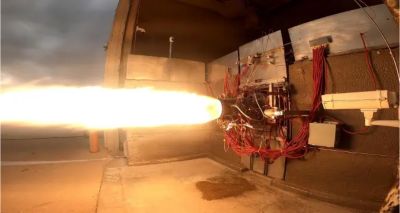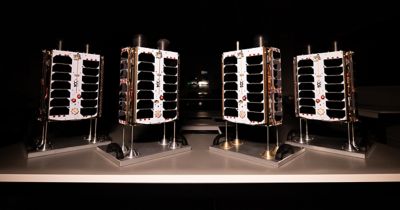-
-
학생용 무료 소프트웨어에 액세스하기
차세대 엔지니어에게 힘을 실어주는 Ansys
학생들은 세계적 수준의 시뮬레이션 소프트웨어를 무료로 이용할 수 있습니다.
-
지금 바로 Ansys에 연결하십시오!
미래를 설계하기
시뮬레이션이 다음 혁신을 어떻게 지원할 수 있는지 알아보려면 Ansys와 연결하십시오.
국가
무료 트라이얼
제품 및 서비스
학습하기
회사 정보
Back
제품 및 서비스

인류는 수년 동안 추진 기술에 힘입어 하늘을 날고 우주를 탐험하면서 새로운 지평을 열 수 있었습니다. 그러나 이 초석 기술은 중요성이 무색하게도 전면적인 발전을 이루지 못했습니다. 오히려 수요가 공급을 초과하는 병목 현상이 발생하고 있습니다.
이러한 어려움은 추진 기술은 비용이 많이 들고 복잡하며 발사 실패를 일으키기 쉽다는 널리 알려진 사실과 맞물리면서 기존 추진 기술과 기법에 대한 대대적인 변경을 주저하게 만듭니다.
이러한 상황에서 Ursa Major가 등장하게 된 것입니다. Ursa Major는 첨단 추진 시스템을 제공하여 방위 및 항공우주 산업의 미래를 강화하는 것을 목표로 합니다. 이를 위해 하드웨어의 한계를 시험하고 신속하게 반복하여 추진에 간절히 필요한 발전과 혁신을 구현함으로써 기존의 검증된 기술을 능가하기 위해 최선을 다하고 있습니다. 그리하여 상업용 우주, 방위 응용 분야 등을 위한 고성능 추진 시스템을 생산할 수 있게 되었습니다.

Ursa Major 엔진 테스트/사진 제공: Ursa Major
최고 엔지니어링 책임자인 Bill Murray는 “Ursa Major의 사명과 비전은 항상 추진 기술을 개발하는 것이었습니다.”라고 말합니다. “추진 기술을 개발하려면 비용이 매우 많이 들고 많은 전문 기술과 지식이 필요하다는 인식이 있었습니다. 많은 추진 기능과 전문 지식을 하나로 통합하면 규모의 경제의 이점을 누릴 수 있습니다.”
이는 Ursa Major를 다른 업체와 차별화하는 전략입니다. 책임 엔지니어인 Louis Villa는 “Ursa Major는 다양한 분야를 다루고 있는데 각 분야마다 전문가가 있다는 점이 특별합니다.”라고 말합니다.
이 특별한 비즈니스 모델에서 Ursa Major는 항상 완벽한 솔루션을 얻지는 못해도 빠르게 움직이는 것을 목표로 합니다. 개발 엔지니어 Travis Thyes는 80%의 솔루션을 달성하는 것이 목표라고 말합니다. Thyes는 이러한 접근 방식을 통해 “각 테스트 후 학습한 내용을 분석하고, 이러한 개선 사항을 통해 계속해서 더 나은 제품을 구현할 수 있습니다.”라고 말합니다.
Ursa Major의 다분야 팀과 타겟팅된 접근 방식은 산업 전반에 임무 성공을 지원할 수 있는 잠재력을 가진 추진 기술의 혁신을 이끌었습니다.
Ursa Major의 추진 기술 살펴보기
Ursa Major는 혁신적이고 경쟁력 있는 가격대의 고성능 턴키형 로켓 엔진을 제공하여 파트너를 지원하는 것을 목표로 합니다. 따라서 적층 제조(AM) 방식에 의존하여 빠른 반복, 부품 공통화, 모듈형 생산, 신속 대응 준비 및 제작 시간 단축을 지원합니다. 고성능이지만 저렴한 산소 과잉 다단 연소 사이클을 사용하고, 신뢰성과 성능에 대한 광범위한 테스트를 수행하며, 재사용이 가능한 제품 제작을 우선으로 합니다.

Ursa Major 엔진/사진 제공: Ursa Major
또한 Ursa Major는 다양한 응용 분야와 엔진 크기에 맞게 설계를 조정합니다. 이러한 다양성 덕분에 다음과 같은 여러 고성능 엔진 구성이 가능합니다.
- Draper: 고체 모터와 똑같은 저장성을 갖춘 유연한 액체 엔진
- Hadley: 미국에서 생산된 최초의 산소 과잉 다단 연소 엔진
- 고체 로켓 모터: Ursa Major의 고체 로켓 모터는 적층 제조 방식으로 제조되며 모든 영역에 맞게 생산할 수 있습니다.
다양한 분야의 고객이 이러한 추진 시스템의 이점을 이용하여 임무에 성공할 수 있습니다.
방위 산업은 이 기술로 큰 수혜를 받을 수 있습니다. Murray는 “Ursa Major는 스스로 현재 미국 국방부(DoD)의 최첨단 개발 부문임을 인식하고 있습니다.”라고 말합니다. 이러한 협업 관계는 회사의 설계 프로세스를 가속화하고 광범위한 임무에 사용할 수 있는 방위 솔루션을 만드는 데 도움이 됩니다.
Ursa Major는 또한 위성 추진 기술을 통해 우주 분야의 발전을 이끄는 데 도움을 주고 있습니다. 이 회사의 추진 기술로 신뢰할 수 있는 발사 솔루션 및 궤도 내 기동성 솔루션을 구현할 수 있습니다. 예를 들어, Ursa Major는 위성 관제에 대해 맞춤형 자유도를 제공하는 모듈식 히드라진 우주 추진 시스템을 개발하고 있습니다.
Murray는 “우리는 현재 매우 다양한 우주, 상업 및 방위 분야에서 실제 임무를 시작할 수 있는 수준까지 발전했습니다.”라고 말합니다. 이러한 발전 과정에서 Ursa Major가 적극적으로 극복하기 위해 노력하고 있는 몇 가지 장애물이 있습니다.
Ursa Major가 직면한 추진 과제
추진 기술은 본질적으로 까다로운 분야입니다. Murray는 “로켓 엔진은 인간이 제작한 기계 중 가장 전력 밀도가 높은 기계 중 하나입니다.”라고 말합니다. “실제로 이는 로켓 엔진의 모든 구성 요소가 한계까지 확장된다는 것을 의미합니다.”
Ursa Major 팀은 임무 목표를 달성하기 위해 설계의 각 부분에서 가능한 최대 성능을 달성해야 합니다. 또한 중량 최소화, 비용 절감, 재사용을 고려한 설계 등의 요소도 고려해야 합니다.

Ursa Major 엔진/사진 제공: Ursa Major
Ursa Major는 신속한 움직임을 목표로 하고 있기 때문에 이러한 과제는 더욱 강조되고 있습니다. Villa는 “우리는 매우 안정적이고 매우 효과적인 제품을 신속하게 개발하기 위해 많은 노력을 기울여야 합니다.”라고 말합니다. “최고의 제품이 필요한 사람들에게 가능한 한 빨리 출시할 수 있는 영리한 지름길을 택하는 것이 가장 중요합니다.”
Ursa Major 기술의 특정 응용 분야에 따라 추가적인 과제가 발생합니다. 예를 들어, 장기 우주 임무에서 궤도 내 기동성은 중요하지만 복잡한 기능입니다. Murray는 “가장 어려운 부분 중 하나는 추진 시스템이 다양한 열 조건과 수년 또는 수십 년의 장기간에 걸쳐 작동할 수 있는지 확인하는 것입니다.”라고 말합니다.
Ursa Major 팀은 이러한 과제를 정면 돌파하기 위해 Ansys Elite Channel Partner인 PADT와 협력하여 시뮬레이션을 선택했습니다.
시뮬레이션을 통한 추진 개발
“Ursa Major에서 시뮬레이션은 일종의 “유도등” 역할을 합니다.”라고 Thyes는 말합니다. Ursa Major 팀은 설계 및 개발 프로세스 전반에 걸쳐 Ansys Mechanical 구조 유한 요소 분석 소프트웨어, Ansys CFX 전산 유체 역학 소프트웨어 및 Ansys Fluent 유체 시뮬레이션 소프트웨어를 포함한 Ansys 소프트웨어를 사용하여 설계의 모든 부분에서 효율성을 높입니다.
예를 들어, 값비싼 하드웨어를 구입해야 하는 실제 테스트 단계로 진행하기 전에 시뮬레이션 소프트웨어를 통해 신속하게 반복 평가를 할 수 있었습니다. Villa는 “무언가를 테스트하기 전에 고장을 예측할 수 있어야 하기 때문에 시뮬레이션은 우리에게 매우 중요합니다.”라고 말합니다.
이처럼 Ursa Major는 물리적 프로토타입 제작으로 넘어가기 전에 잠재적인 문제를 식별하고 이해할 수 있습니다. Murray는 “시뮬레이션은 첫 번째 시도에서 최종 결과에 실제로 근접하는 데 핵심적인 역할을 했습니다.”라고 말합니다.
이는 Ursa Major가 다루는 복잡한 문제, 즉 다양한 특성을 가진 여러 소재를 다루는 문제에 특히 중요합니다. 특정 재료를 나란히 배치하면 문제가 발생할 수 있으므로 Villa는 “환경을 재현하고 서로 다른 컴포넌트가 인접해 있을 때 발생하는 응력을 파악하는 것은 설계 프로세스에 매우 유익합니다.”라고 말합니다. Ursa Major는 Ansys 시뮬레이션 솔루션을 사용하여 컴포넌트가 서로 상호 작용하는 방식을 예측한 다음 각 개별 구성 요소의 성능을 개선하는 방법을 결정할 수 있습니다.
시뮬레이션 소프트웨어는 간소화된 팀을 지원하는 등 다른 방법으로도 비용을 절감할 수 있습니다. Murray는 “최신 소프트웨어 덕분에 개발에 필요한 인력이 줄어들면서 개인이 이전보다 훨씬 많은 일을 할 수 있게 되었습니다.”라고 말합니다. 또한 시뮬레이션 도구와 분석을 맞춤 설정하면 “분석에 공통의 언어를 사용할 수 있습니다.”라고 Villa는 말합니다. “누구나 내가 수행한 작업을 볼 수 있으며 […] 결과와 해당 구성 요소의 작동 여부를 이해할 수 있습니다.”
시뮬레이션 소프트웨어는 까다로운 임무, 특히 우주에서의 임무를 설계할 때 특히 유용합니다. Murray는 “항상 우주에서 테스트할 수는 없기 때문에 일반적으로 이러한 문제는 분석을 통해서만 해결할 수 있습니다.”라고 말합니다. “따라서 우리의 분석 도구는 고객이 우리의 하드웨어가 지상에서 우주로 이동하든 장기간 우주에 머물든 제대로 작동할 것이라는 것을 확신하는 데 정말 중요합니다.”
Ursa Major는 창립 이래로 지금까지 시뮬레이션 소프트웨어를 사용하여 비전을 추구해 왔습니다. Ursa Major는 액체 로켓 엔진을 처음부터 제작한다는 목표로 창립되었는데, 단 6명의 인원만으로 이 목표를 달성했습니다. Murray는 “이는 고급 소프트웨어 기법 덕분에 가능했습니다.”라고 말합니다. 오늘날 시뮬레이션은 Ursa Major 팀에게 여전히 중요한 도구들입니다. Villa는 “현재의 연산 능력과 도구가 없었다면 지금처럼 적은 수의 인원만으로 빠르게 엔진을 개발할 수 없었을 것입니다.”라고 말합니다.
Ursa Major가 성장하고 적응하는 방법
Villa가 생각하는 Ursa Major의 두 가지 발전 목표는 다음과 같습니다.
- 기존 엔진 설계의 발전 계속
- 진화하는 시장 요구 사항을 충족하기 위해 현재 엔진을 조정하거나 신규 엔진 개발
후자의 목표 중 하나는 성장하는 우주 산업에 적응하는 것입니다. Murray는 “우주는 많은 위대한 가능성, 탐험, 확장을 나타냅니다.”라고 말합니다. Ursa Major는 이러한 성장 잠재력에 보조를 맞추기 위해 고체 로켓 모터와 같은 새로운 응용 분야로 추진 기술 응용 분야를 확장할 계획입니다.
Ursa Major는 이러한 목표를 달성하는 것과 관련하여, 이러한 발전이 결실을 맺을 것이라고 매우 낙관하고 있습니다.
Murray는 “향후 10년 동안 Ursa Major는 국내외적으로 성장할 수 있는 엔진을 제공할 것으로 보입니다.”라고 말합니다.
Advantage 블로그
Ansys 및 다른 기술 전문가의 기고문을 제공하는 Ansys Advantage 블로그에서는 Ansys 시뮬레이션이 인간의 발전을 촉진하는 혁신을 어떻게 지원하는지에 대한 최신 소식을 계속해서 전해 드립니다.



